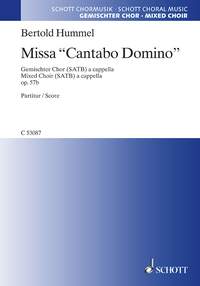Missa Cantabo Domino for 4 part mixed Choir a cappella, op. 16 (1958)

II. Gloria
III. Credo
V. Agnus Dei
Duration: 14 Minutes
Publisher: Schott Music C 53087 / ISMN: M-001-15431-4Video: Works by Hummel on youtube
The
Missa Cantabo Domino, op. 16 for four-part mixed choir a cappella
was composed in 1958 for a celebration of the Mass liturgy by a catholic student
association in Freiburg im Breisgau. The composition was required to be comfortably
performable for an amateur choir. For this reason, it is a model of brevity and
terseness and, with a few exceptions, does not use text repetition.
The Kyrie
is in three sections; at the end of the movement the musical material of the Christe
is heard again as a kind of coda.
In the Gloria, the bass part
with chorale-like melodic ideas stands in contrast to the choir as a whole, which
recites in homophonic blocks.
The long text of the Credo is,
in the style of psalmody, woven into three modal chord patterns. Thus a high degree
of objectivity is achieved, reinforced by the presentation of the individual statements
of the confession by alternating choirs.
In the Sanctus, on
the other hand, sections characterised by canons and by homophonic treatment provide
contrasting elements.
The three-fold prayer of the Agnus Dei
begins a whole tone higher each time, the Dona nobis pacem being repeated
three times as a kind of closing theme.
In
performance (particularly in the Gloria and Credo), great attention
should be paid to fluent rhythm taking into account a natural accentuation of
words, where-by the note values remain as in the Gregorian chant. The dynamics
are to a large extent subordinate to the text declamation.
Bertold Hummel
Press
Musik
und Altar, January, 1959
In
advance, Bertold Hummel's Missa "Cantabo Domino" has to be mentioned
as a pleasing exception. Here the call of the Church for a primacy of the text
is most happily united with a contemporary concept of sonority and ease of performance.
In addition, the frequent doubling of parts and versicular repetitions along with
the easily-learnt lines - always in optimal registers - guarantee a short rehearsal
time. The expert will find (in the Credo) echoes of Stravinsky's Mass. The score
is exemplary in its plan and legibility and can also be recommended for smaller
choirs.
H.L. Schilling
Weil
am Rhein, 1958
On the occasion of a Sunday visit to Weil, the "Sacred Choir" of the Pedagogical Academy in Freiburg sung during the high Mass of the Pax-Christi-Curatorium the new Mass composition "Cantabo Domino" by the young Freiburg composer Bertold Hummel. This work, written for four-part mixed choir, was fitted perfectly to the liturgical concept of the service and formed together with the Gregorian chants for the Proper sung by the Schola an intentionally coherent stylistic unity. Hummel's work is compact in its melodic formulation and keeps strictly to the task of presenting the text comprehensibly; it always aware that proclaiming the Word must be the starting point and the constantly sought focus for music for liturgical purposes. The harmonic component is somewhat subordinate to other functions. In the Credo, where the four voices move in unified rhythm through a long chain of chords, the harmony takes on more importance.